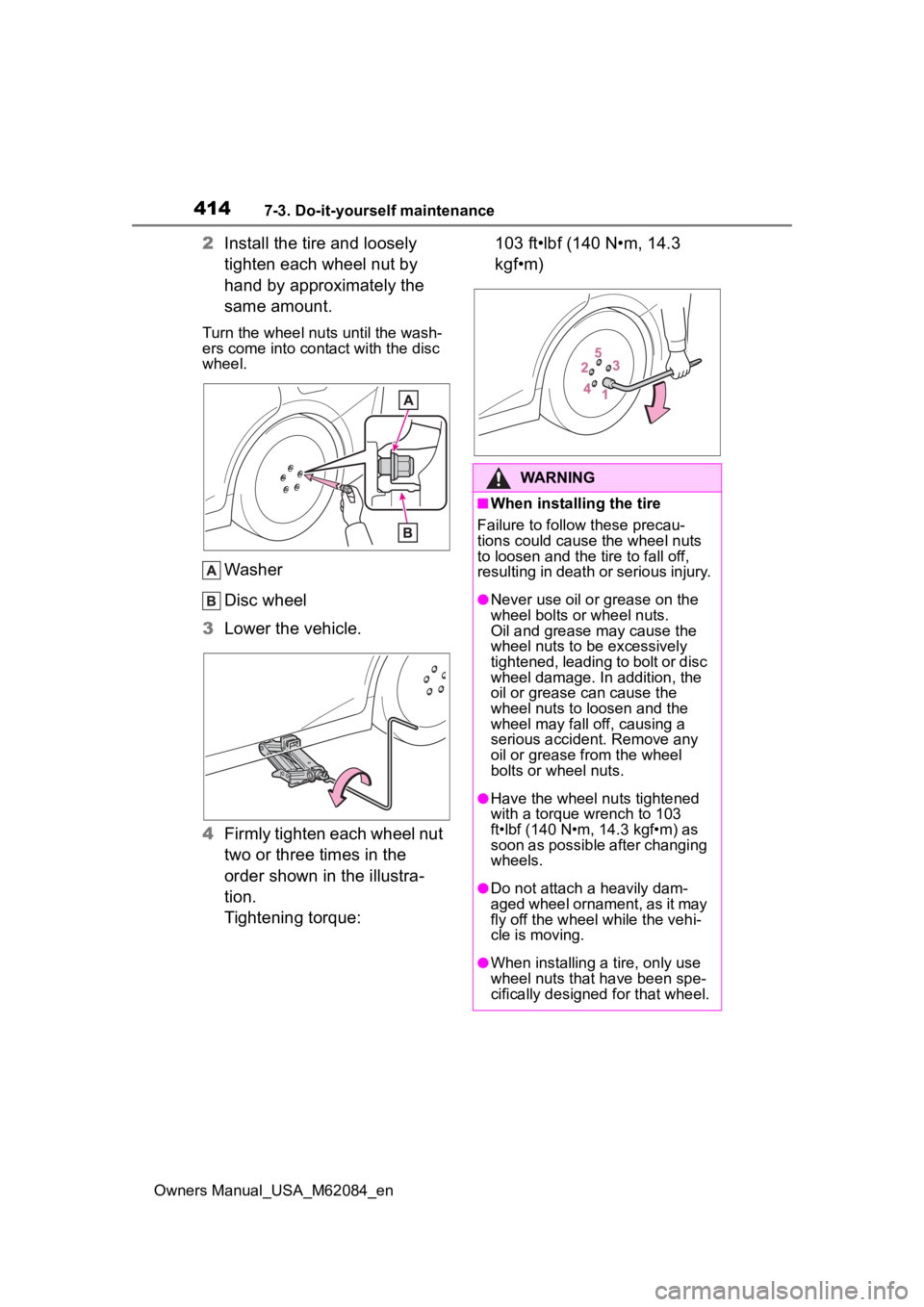Page 89 of 556

892-1. Fuel cell vehicle
Owners Manual_USA_M62084_en
2
Fuel cell systemMaintaining the fuel cell system
indicator to Eco area on the
multi-information display can
extend your driving range.
( P.102)
Drive your vehicle smoothly.
Avoid abrupt acceleration and
deceleration.
Mild acceleration and decelera-
tion can help curb wasteful fuel
consumption.
If the brakes are operated gently
and in a timely manner, a
greater amount of electrical
energy can be regenerated
when slowing down.
Repeated acceleration and
deceleration, as well as long
waits at traffic lights, will lead to decreased fuel economy. Check
traffic reports before leaving and
avoid delays as much as possi-
ble. When driving in a con-
gested traffic situations, gently
release the brake pedal to allow
the vehicle to move forward
slightly while avoiding overuse
of the accelerator pedal. Doing
so can help control excessive
fuel consumption.
Similar to an electric vehicle, a
fuel cell vehicle uses the most
fuel in high output driving such
as driving on a steep uphill or at
high speeds. Moderate the vehi-
cle speed and maintain a steady
speed.
When using Eco drive mode, the
torque corresponding to the
accelerator pedal depression
amount can be generated more
smoothly than it is in normal
conditions. In addition, the oper-
ation of the air conditioning sys-
tem (heating/cooling) will be
minimized, improving the fuel
economy. (
P.313)
Use the air conditioning only
when necessary. Doing so
Fuel cell vehicle driv-
ing tips
To maximize fuel economy
and range, pay attention to
the following:
Use of fuel cell system
Indicator
Accelerator pedal/brake
pedal operation
When braking
Delays
Driving with high power
output
Using Eco drive mode
Air conditioning
Page 414 of 556

4147-3. Do-it-yourself maintenance
Owners Manual_USA_M62084_en
2Install the tire and loosely
tighten each wheel nut by
hand by approximately the
same amount.
Turn the wheel nuts until the wash-
ers come into contact with the disc
wheel.
Washer
Disc wheel
3 Lower the vehicle.
4 Firmly tighten each wheel nut
two or three times in the
order shown in the illustra-
tion.
Tightening torque: 103 ft•lbf (140 N•m, 14.3
kgf•m)
WARNING
■When installing the tire
Failure to follow these precau-
tions could cause the wheel nuts
to loosen and the tire to fall off,
resulting in death o r serious injury.
●Never use oil or grease on the
wheel bolts or wheel nuts.
Oil and grease may cause the
wheel nuts to be excessively
tightened, leading to bolt or disc
wheel damage. In addition, the
oil or grease can cause the
wheel nuts to loosen and the
wheel may fall off, causing a
serious accident. Remove any
oil or grease from the wheel
bolts or wheel nuts.
●Have the wheel nuts tightened
with a torque wrench to 103
ft•lbf (140 N•m, 14.3 kgf•m) as
soon as possible after changing
wheels.
●Do not attach a heavily dam-
aged wheel ornament, as it may
fly off the wheel while the vehi-
cle is moving.
●When installing a tire, only use
wheel nuts that have been spe-
cifically designed for that wheel.
Page 484 of 556
4849-1. Specifications
Owners Manual_USA_M62084_en
Electric motor (traction motor)
Ty p ePermanent magnet synchronous
motor
Maximum output134 kW
Maximum torque221.3 ft•lbf (300 N•m, 30.6 kgf•m)
Traction battery
Ty p eLithium-ion battery
Voltage3.7 V/cell
Capacity4.0 Ah
Quantity84 cells
Nominal voltage310.8 V
Cooling system
Capacity*
Fuel cell
stack17.3 qt. (16.4 L, 14.4 Imp. qt.)
Inverter4.2 qt. (4.0 L, 3.5 Imp. qt.)
Page 487 of 556
4879-1. Specifications
Owners Manual_USA_M62084_en
9
Vehicle specifications
the brake system warning light is not illuminated when the fuel cell sys-
tem is operating. (If the brake system warning light is illuminated, refer to
P.441.)
*2: Make sure to confirm that the brake warning light (yellow) doe s not illumi-
nate. (If the brake warning light illuminates, refer to P.441.)
19-inch tires
20-inch tires
Steering
Free playLess than 1.2 in. (30 mm)
Tires and wheels
Tire size235/55R19 101V
Tire inflation pressure
(Recommended cold tire
inflation pressure)Front: 33 psi (230 kPa, 2.3 kgf/cm2 or bar)
Rear: 33 psi (230 kPa, 2.3 kgf/cm
2 or bar)
Wheel size19 8J
Wheel nut torque103 ft•lbf (140 N•m, 14.3 kgf•m)
Tire size245/45ZR20 103Y
Tire inflation pressure
(Recommended cold tire
inflation pressure)Front: 33 psi (230 kPa, 2.3 kgf/cm2 or bar)
Rear: 33 psi (230 kPa, 2.3 kgf/cm
2 or bar)
Wheel size20 8 1/2J
Wheel nut torque103 ft•lbf (140 N•m, 14.3 kgf•m)